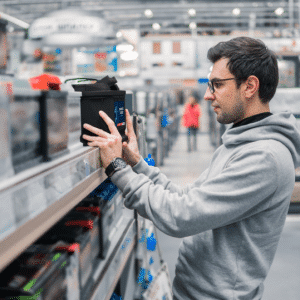
Based on the age of the lead battery industry, it’s easy to see why there are many myths about automotive batteries. The lead battery has been used in automotive engines since the electric starter motor was introduced in the 1920s. A lot has changed since then. Until the mid-1950s, cars used 6-volt electrical systems and batteries. In the 1970s, the introduction of maintenance-free batteries reduced or eliminated the need to add water to them.
The increased computerization of today’s vehicles has led to advanced lead battery technology to meet the power requirements of advanced safety features and modern conveniences. But even with these advancements, there are a few lingering myths about automotive batteries.
1. Don’t put a battery on cement to charge or store it on the ground.
This was actually a true fact back when batteries were produced with hard rubber case material. The porous rubber would take on the moisture of the floor, creating an electrical current between the battery cells causing them to discharge. Distributors would make sure the batteries were stored on a wooden pallet to act as an insulator between the battery case and the concrete flooring.
Today’s battery casings are made of plastic, eliminating the intake of moisture, and making the garage floor a great place to put your car battery. Cement and concrete floors provide a fairly good barrier between the car battery and extreme temperature changes that could otherwise cause damage to the battery cells. Just don’t let it sit unused too long.
2. Use aspirin to revive a dead battery.
Got a dead battery and don’t have jumper cables? Take two aspirin for your headache and give some to your battery. Another myth about automotive batteries.
While there are a number of hacks that can be found online, this one probably isn’t worth trying. If you have distilled water and aspirin, or acetylsalicylic acid, you can make a solution to chemically alter the electrolyte mix. However, tests show a battery that is discharged, when enhanced with acid and distilled water, did nothing to increase voltage for the battery.
It would be better to call roadside assistance for a jumpstart, then head to the mechanic to determine what caused the failure.
3. Add sulfuric acid to a battery to strengthen it.
Under normal circumstances, the sulfuric acid content in battery electrolyte never changes. It’s either present in the water solution as an electrolyte or absorbed into the lead plates.
Some batteries, such as golf cart and lawn & garden batteries, need to be checked regularly and topped with distilled water as needed. Most automotive batteries are now maintenance-free, eliminating the need for watering. Adding acid will actually make a battery deteriorate faster.
4. If you ever have to jumpstart a battery, just let it run for a few minutes.
The starter motor draws its power from the battery. It requires quite a bit of power, so if the vehicle’s battery is running low, the engine may not be able to be started. A jumpstart from another battery will provide enough charge to start the engine.
However, the alternator produces the majority of your vehicle’s electricity and helps recharge the battery. You should drive your vehicle for at least 15-30 minutes to allow the alternator to charge the battery and ensure that your vehicle does not die again once you turn it off.
If you must jumpstart your car, assuming you left something on that drained the battery, it is also recommended that you put a charger on the battery as soon as possible.
5. You can test or charge all batteries the same way.
While all automotive batteries may basically serve the same function, they are not all designed the same. It is important to identify the type of battery to be tested or charged. Is it a flooded battery or an absorbed glass mat (AGM) battery? The peak voltage for flooded batteries is 12.65 volts, compared to 13.2 volts for AGM. Flooded batteries have a different testing and charging method. Modern chargers also have AGM settings that are different than flooded batteries.
You should also be aware of the group size. This classification refers to the battery size that will best fit the physical dimensions, terminal locations and type required for your vehicle. There are typically three types of terminals on automotive batteries, depending on the type of vehicle, whether it is a car, a truck or a recreational vehicle.
Some batteries come with terminals in two different configurations. The specific terminal type and configuration will determine how you will test or charge your battery. Some terminals require an adapter test or charge the battery. Without it, you will get a bad reading or in the worst case, melt the terminals and cause a fire.
6. AGM is the best battery you can buy.
This is another myth about automotive batteries. Today’s vehicles are packed with advanced safety features and modern conveniences that demand a lot from the battery. In the past decade, there has been a 30 percent increase in cycling failures due to additional computerization. New battery technologies, such as Enhanced Flooded Batteries (EFB) and Absorbed Glass Mat (AGM) have been developed to meet these needs.
There are several questions to ask when selecting a replacement battery. What type of battery was installed by the manufacturer? Does my battery need to provide additional energy to support advanced electronics? Is my car subject to high heat in the summer months? How often do I drive the car, and how long is it on the road?
Depending on the answers, AGM may or may not be the right fit for your needs. Because of its increased battery life, high heat tolerance, durability and greater energy availability, EFB is a suitable replacement for vehicles with standard flooded batteries under the hood.
As you can see, there are many myths about automobile batteries. Today’s advanced stored energy technologies allow us to easily debunk these myths.







